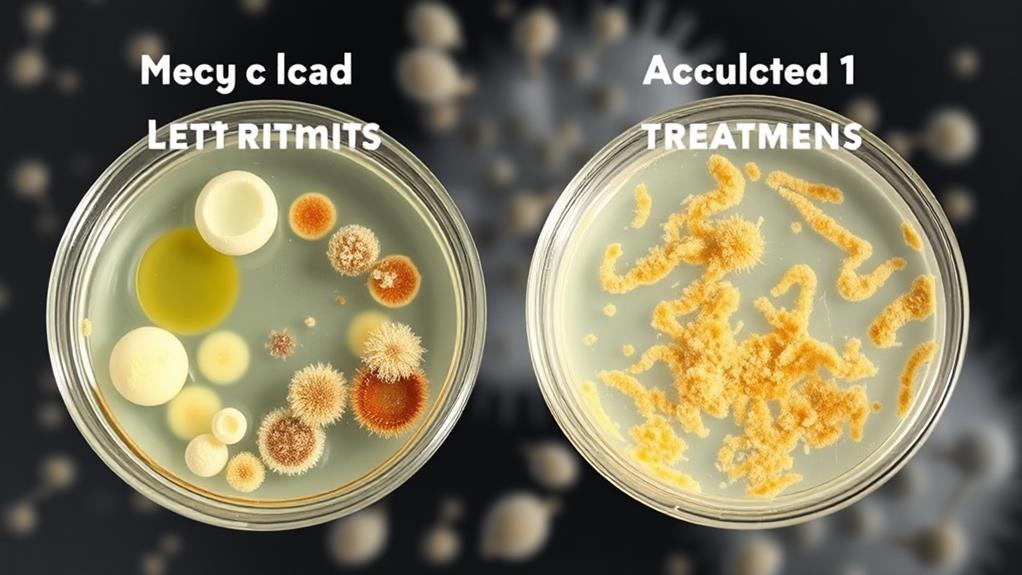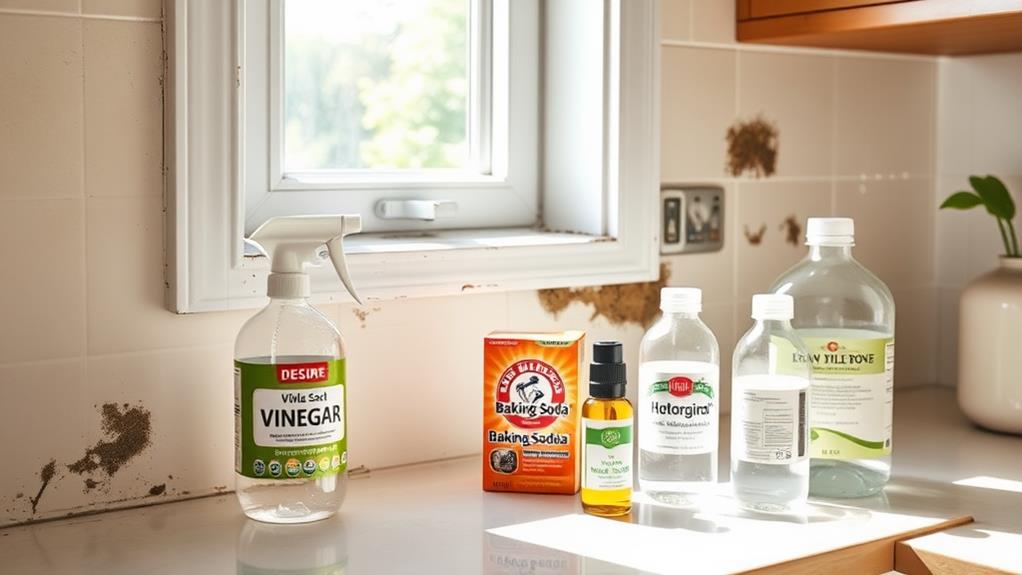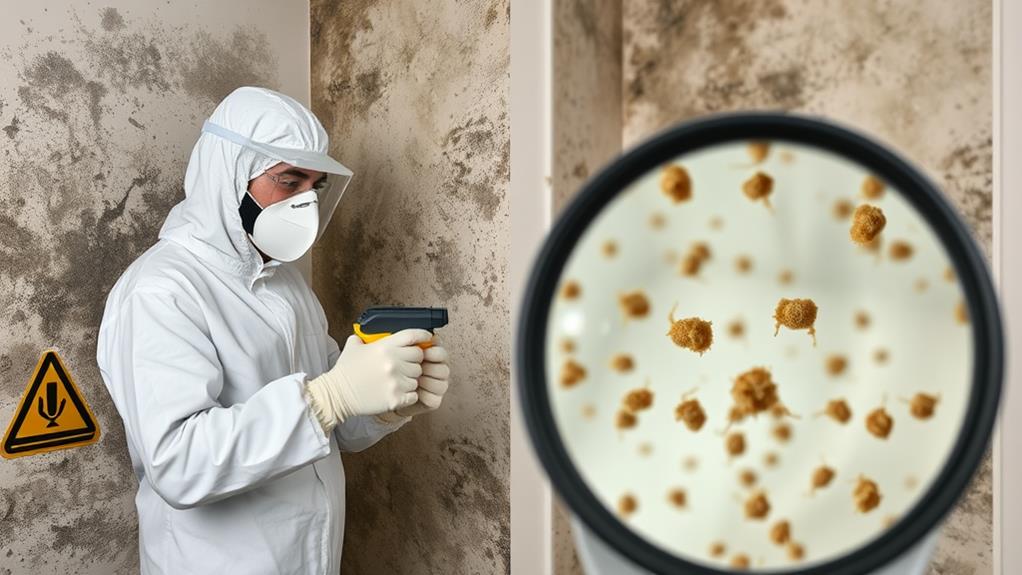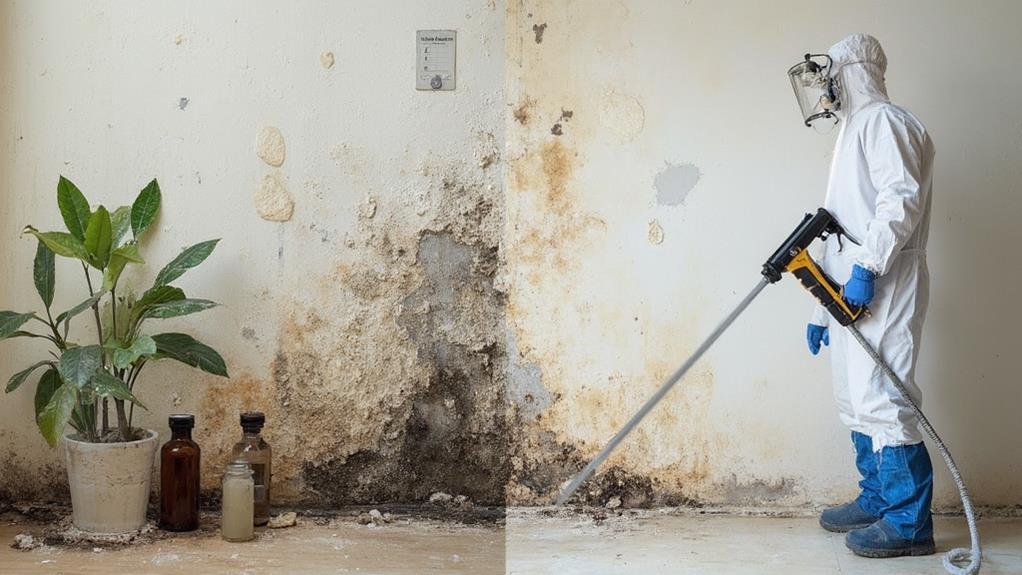Natural and chemical mold remediation methods each have distinct advantages and drawbacks. Natural approaches, like vinegar or tea tree oil, are safer, more environmentally friendly, and cost-effective but may be less potent for severe infestations. Chemical treatments, including bleach and commercial biocides, offer stronger and faster results but pose potential health risks and environmental concerns. Natural methods excel in prevention and minor cases, while chemicals are often necessary for extensive mold problems. The choice depends on the severity of the infestation, health considerations, and environmental impact. Understanding the pros and cons of each approach is crucial for making an informed decision about mold remediation.
Understanding Mold Growth

To fully grasp the concept of mold remediation, one must first understand the nature of mold growth. Mold is a type of fungus that thrives in moist environments and reproduces through microscopic spores. These spores are present in both indoor and outdoor air, constantly seeking suitable conditions to proliferate.
Mold growth occurs when spores land on damp surfaces and find adequate nutrients. Common indoor mold growth sites include bathrooms, kitchens, basements, and areas affected by water damage or high humidity. The process begins within 24-48 hours of moisture exposure, with visible growth appearing within 1-2 weeks.
Factors influencing mold growth include temperature, humidity, light, and available nutrients. Most molds prefer temperatures between 60-80°F (15-27°C) and relative humidity above 60%. While some molds require light for growth, others thrive in darkness.
Understanding these growth conditions is crucial for effective mold remediation. By controlling moisture levels, improving ventilation, and addressing water intrusion issues, one can create an environment less conducive to mold growth. This knowledge forms the foundation for both natural and chemical remediation methods, enabling targeted and efficient mold removal strategies.
Chemical Remediation Techniques
What are the most effective chemical methods for combating mold infestations? Several potent chemical solutions have proven highly effective in mold remediation. Chlorine bleach, a common household product, is widely used for its ability to kill surface mold on non-porous materials. However, it may not penetrate porous surfaces effectively.
Commercial biocides, specifically designed for mold treatment, offer a more comprehensive approach. These products often contain quaternary ammonium compounds or hydrogen peroxide, which eliminate mold and prevent its regrowth.
For severe infestations, professionals may employ stronger chemicals like sodium hypochlorite or ammonium chloride. These industrial-grade solutions provide thorough mold eradication but require careful handling due to their potency. Encapsulants, another chemical option, work by sealing mold spores and preventing their spread. This method is particularly useful in areas where complete mold removal is challenging.
Fungicides containing ingredients like iodine or silver can also be effective in controlling mold growth. When selecting a chemical remediation technique, it's crucial to consider the surface material, extent of infestation, and potential health risks associated with the chosen product.
Natural Remediation Approaches

Natural remediation approaches offer environmentally friendly alternatives to chemical treatments for mold removal. These methods utilize non-toxic substances and techniques to eliminate mold growth and prevent its recurrence. Common natural remedies include vinegar, tea tree oil, hydrogen peroxide, and baking soda.
Vinegar, with its acetic acid content, effectively kills most mold species when applied directly to affected surfaces. Tea tree oil, a potent antifungal agent, can be diluted and sprayed onto moldy areas. Hydrogen peroxide, available in 3% concentration, oxidizes mold spores and can be used on various surfaces. Baking soda, mixed with water to form a paste, helps absorb moisture and inhibit mold growth.
Other natural approaches involve improving ventilation, reducing humidity levels, and increasing sunlight exposure in affected areas. Air purifiers with HEPA filters can remove airborne mold spores, while dehumidifiers help maintain optimal moisture levels. Regular cleaning with natural disinfectants and proper maintenance of potential problem areas are crucial for long-term mold prevention. While natural methods may require more frequent application than chemical treatments, they pose fewer health risks and environmental concerns.
Effectiveness Comparison
A comprehensive comparison of natural and chemical mold remediation methods reveals distinct advantages and limitations for each approach. Natural methods, such as vinegar, tea tree oil, and hydrogen peroxide, are generally safer for occupants and the environment. They pose fewer health risks and are less likely to cause damage to surfaces. However, their effectiveness can be limited, especially for extensive or deep-rooted mold infestations.
Chemical methods, including bleach, ammonia, and commercial fungicides, tend to be more potent and fast-acting. They can effectively eliminate a wider range of mold species and are often preferred for severe cases. However, these products may release harmful fumes, irritate skin and eyes, and potentially damage treated surfaces.
In terms of long-term efficacy, chemical treatments may provide more thorough eradication but do not address underlying moisture issues. Natural methods, while potentially less effective initially, can be used more frequently without adverse effects and may help prevent future mold growth when combined with proper moisture control. The choice between natural and chemical remediation should consider the extent of the mold problem, health concerns, and environmental impact.
Health and Safety Considerations

When considering mold remediation methods, health and safety should be paramount concerns for both occupants and remediation professionals. Natural remediation methods often utilize less toxic substances, such as vinegar, tea tree oil, or hydrogen peroxide, which can reduce exposure to harsh chemicals. These options may be safer for households with children, pets, or individuals with chemical sensitivities.
Chemical remediation methods, while potentially more effective, can pose health risks if not used properly. Many commercial mold removers contain bleach, ammonia, or other strong chemicals that can cause respiratory irritation, skin burns, or toxic fumes when mixed incorrectly. Proper ventilation, protective equipment, and adherence to safety guidelines are crucial when using these products.
Both natural and chemical methods require caution to prevent the spread of mold spores during removal. Containment measures, such as sealing off affected areas and using HEPA air filtration, are essential regardless of the chosen method. Additionally, addressing the underlying moisture problem is critical to prevent mold recurrence and ensure long-term health benefits. Ultimately, the safest approach may involve professional assessment and remediation, especially for extensive mold infestations or when dealing with toxic mold species.
Environmental Impact Assessment
Assessing the environmental impact of mold remediation methods is crucial for making informed decisions about treatment options. Natural remediation techniques generally have a lower environmental footprint compared to chemical alternatives. These methods often utilize non-toxic, biodegradable substances such as vinegar, hydrogen peroxide, or tea tree oil, which pose minimal risks to ecosystems when disposed of properly.
Chemical mold remediation, while effective, can have more significant environmental consequences. Many commercial fungicides and biocides contain harsh chemicals that may persist in the environment, potentially harming soil microorganisms, aquatic life, and air quality. The production and disposal of these chemicals also contribute to increased carbon emissions and waste generation.
When evaluating environmental impact, consider factors such as biodegradability, toxicity to non-target organisms, and resource consumption during production and application. Additionally, assess the long-term effects of chosen remediation methods on indoor air quality and the potential for chemical residues to accumulate in living spaces. Ultimately, selecting a mold remediation approach that balances efficacy with minimal environmental harm is essential for sustainable and responsible mold management practices.
Cost Analysis and Accessibility

Cost considerations play a significant role in choosing between natural and chemical mold remediation methods. Natural remedies, such as vinegar, tea tree oil, and baking soda, are generally more affordable and readily available in most households. These options typically cost a fraction of commercial chemical products, making them accessible to a broader range of consumers. However, for larger infestations or commercial applications, the quantity required may offset initial cost savings.
Chemical mold remediation products, while often more expensive upfront, can be more potent and efficient, potentially reducing labor costs and time invested. Professional-grade chemical treatments may require specialized equipment or expertise, further increasing overall expenses. However, their effectiveness in severe cases may justify the higher cost.
Accessibility is another crucial factor. Natural remedies are easily obtainable from grocery stores or online retailers, allowing for immediate action. Chemical products may require purchasing from specialized suppliers or hiring professional services, which can delay treatment and increase costs. Additionally, some chemical treatments may have restrictions on sale or use, limiting their accessibility to the general public.
Frequently Asked Questions
How Long Does Mold Remediation Typically Take?
The duration of mold remediation typically varies depending on the extent of the infestation and the size of the affected area. Small-scale projects may take 1-5 days, while larger or more complex cases can require several weeks to complete.
Can I Stay in My Home During Mold Remediation?
Home sweet home, or temporary exile? During mold remediation, staying put depends on the extent of contamination and remediation methods used. For safety, professionals often recommend vacating the premises, especially for sensitive individuals or extensive treatments.
Are There Any Mold-Resistant Building Materials I Can Use?
Yes, several mold-resistant building materials are available. These include moisture-resistant drywall, mold-inhibiting paints, treated wood products, and specialized insulation. Additionally, materials like cement board, ceramic tile, and certain plastics naturally resist mold growth when properly installed and maintained.
How Often Should I Conduct Mold Inspections in My Home?
Coincidentally, regular mold inspections can prevent costly repairs. Conduct visual checks monthly, focusing on moisture-prone areas. Professional inspections are recommended annually, or biannually in humid climates. Immediate inspection is necessary after water damage or flooding events.
Can Mold Return After Remediation, and How Can I Prevent It?
Yes, mold can return after remediation if moisture issues persist. To prevent recurrence, maintain proper ventilation, control humidity levels, fix leaks promptly, and ensure thorough drying after water exposure. Regular inspections and addressing underlying causes are crucial for long-term prevention.
Conclusion
In the battle against mold, chemical and natural remediation methods stand as warriors on opposing sides. While chemicals wield swift, powerful blades, natural approaches offer gentler, sustainable shields. The choice between them mirrors humanity's broader struggle with environmental stewardship. As mold spores represent life's persistence, so too does the remediation decision reflect our values. Balancing effectiveness, health, cost, and ecological impact, the ideal solution may lie in a harmonious blend of both approaches, much like nature's own delicate equilibrium.

